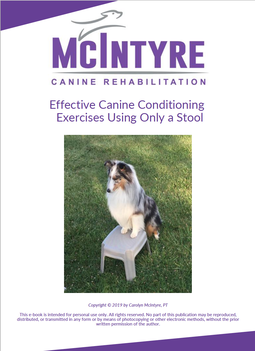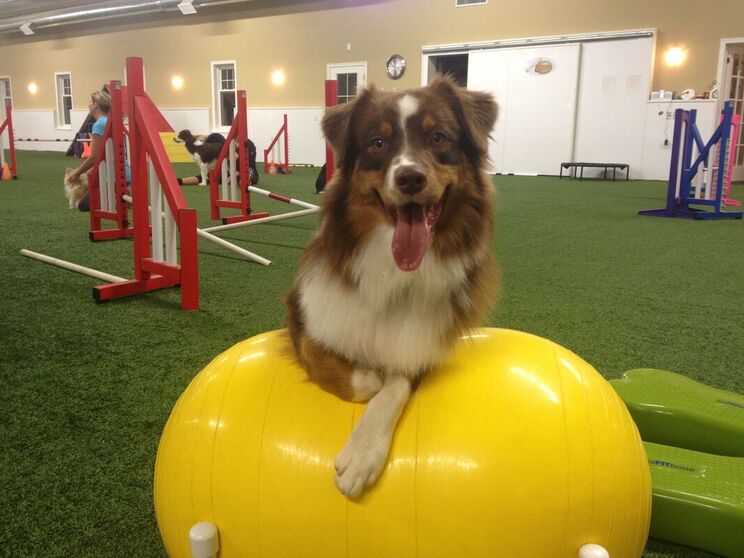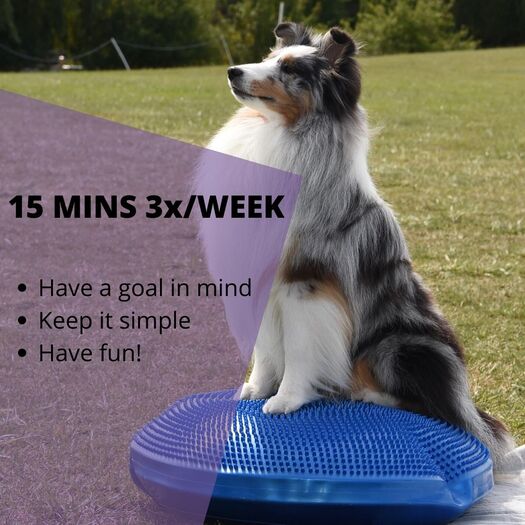|
What exactly is canine conditioning? We’ve heard that we should be doing it with our dogs but what does conditioning actually do for our dogs and how does it improve their performance? Canine conditioning is important for all dogs, but particularly for our canine athletes. Through specific exercises we can improve body awareness, flexibility, balance, speed, mobility and muscular strength – which overall improves our dog’s performance and reduces their risk of injury. As well, conditioning increases our dog's ability to carry load on their muscles. This is important as injuries occur when muscles experience excessive lengthening and stretching that are unprepared for such a load. Another factor in injuries is fatigue in the muscles which causes our dogs to lose their ability to maintain position or cause stumbles and falls. While exercise like long walks or running in the back yard are good for maintaining large muscle groups the deeper muscles which activate when our dog loses balance or tries to avoid slipping are often neglected and are often the areas, we see greater injury in. Conditioning exercises not only have physical benefits to your dog but also mental ones! They are a great way to strengthen the bond you have with your dog – they love playing with you! What should a conditioning program include?
Challenges to Starting a Conditioning ProgramI have a confession to make – when I first started my business I was overwhelmed – lots was happening and life got in the way – conditioning of my own dogs fell to the wayside. It was in that first summer that my Aussie Quinn got injured and it took that injury for me to start prioritizing conditioning. I recently asked my Facebook followers what prevented them from starting a conditioning program with their dog. The top three responses were; time, expense, and uncertainty on where to begin or how to progress their program. These are all what I would call barriers of resistance – something that prevents us from even getting started. It’s important when you run up against barriers of resistance to understand where they come from and how to break through them as many times the barrier itself isn’t as insurmountable as they appear! What are some strategies to save time?
Live in a multi-dog household? Start with just one dog and work your way up. It’s better to be consistent with one than not enough with all. Once you start to develop better habits, you can incorporate more dogs or once you are more comfortable organizing a training session, working multiple dogs at a time. How to limit costs? Just because you see people online with a whole compliment of K9 fitness equipment doesn't mean you need to have a full gym to get effective workouts. In fact, you can get lots done with everyday household items like a stool! The stool is a safe way to learn many of the basics of canine conditioning exercises before advancing to more unstable objects and surfaces and is a $10-$20 investment that really pays off! If you would a copy of this e-book enter your information below and I'l send you a copy! Uncertainty on where to start or how to progressI'm here to help! If you're not sure how to start a conditioning program take some time to go through my website and visit my YouTube for some guidance on how to begin your conditioning program or how to progress exercises. I'm also always happy to answer any questions you may have. Make sure to drop a comment below or shoot me an email (carolyn@mcrehabilitation.ca) and let me know what you're struggling with!
7 Comments
Deborah
11/15/2019 11:22:08 am
Hi, great blog. I would love to better understand how to devise a suitable warm up routine for my obedience dog. I usually take him for a walk and work through some simple exercises (twist, turn, sit, stand, down, walk forward, walk back) before doing some heel work an hour before we are due to compete. We usually have a five minute walk to the ring side when it's our turn to compete. But I think I need to also understand better what stretches to do and have a plan. Thank you. Deb
Reply
Carolyn McIntyre
11/16/2019 05:32:10 am
Hi Deb,
Reply
Karey Grisdale
11/16/2019 04:00:15 pm
Great blog!
Reply
Carolyn McIntyre
11/17/2019 06:05:34 am
Thank you so much Karey!!!! Glad you liked it!! :)
Reply
Gail Coady
11/17/2019 03:28:50 am
Some great information thanks for sharing. I often stress myself out thinking I’m not doing enough or when I’m short on time.
Reply
Carolyn McIntyre
11/17/2019 06:07:30 am
You are most welcome Gail!! Definitely don't stress!! I'm trying to create ways to simplify canine conditioning. We don't need hours and hours each week. 15 minutes 3x a week can REALLY make a big difference in your dog's physical strength and conditioning. If you ever need any help with strategizing - let me know!! Always here to help! :)
Reply
Gail
11/17/2019 06:04:53 pm
Thank you! Leave a Reply. |
AuthorCarolyn McIntyre Archives
March 2024
Categories
All
|



 RSS Feed
RSS Feed